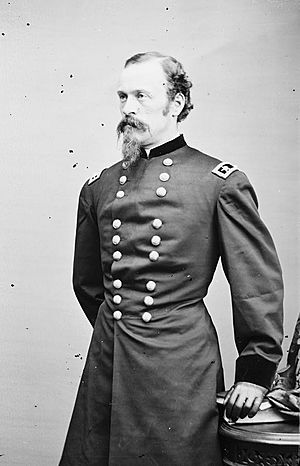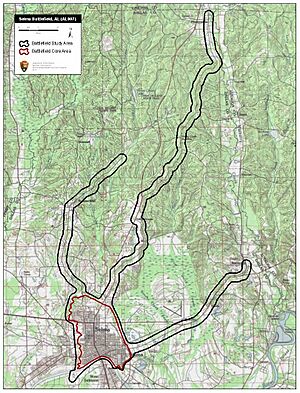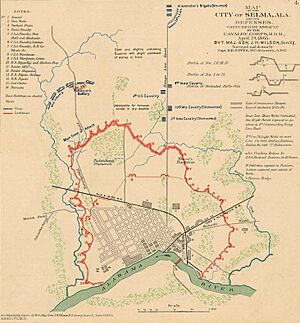Battle of Selma facts for kids
Quick facts for kids Battle of Selma |
|||||||
|---|---|---|---|---|---|---|---|
| Part of American Civil War | |||||||
|
|||||||
| Belligerents | |||||||
| Commanders and leaders | |||||||
| James H. Wilson | Nathan Bedford Forrest | ||||||
| Units involved | |||||||
| Cavalry Corps, Military Division of the Mississippi | Forrest's Cavalry Corps Militia |
||||||
| Strength | |||||||
| 9,000 | 4,000 | ||||||
| Casualties and losses | |||||||
| 359 | 2,700 | ||||||
The Battle of Selma happened in Selma, Alabama, on April 2, 1865. It was a big part of a Union Army plan called Wilson's Raid. This raid moved Union soldiers through Alabama and Georgia. It took place in the very last month of the American Civil War.
Union soldiers, led by Major General James H. Wilson, had about 13,500 troops. They marched into southern Alabama. The Confederate forces, led by Lieutenant General Nathan Bedford Forrest, had only about 2,000 men. Many of Forrest's soldiers were young boys or older men.
Before reaching Selma, Forrest's troops were defeated at the Battle of Ebenezer Church. He then quickly went back to Selma. The city's defenses were strong but didn't have enough soldiers to guard them. Wilson's troops broke through the defenses in many places. This forced the Confederates to give up the city.
Wilson's army captured many prisoners. However, General Forrest and Lieutenant General Richard Taylor managed to escape. Union troops then destroyed important factories and military supplies in Selma. This defeat showed that the Union Army could go anywhere in the South. It was a big blow to the Confederates.
Contents
Why the Battle Happened
On March 30, 1865, General Wilson sent a group of his soldiers to destroy Confederate property in Tuscaloosa, Alabama. Wilson's men also captured a Confederate messenger. This messenger had important papers from General Forrest. The papers showed where Forrest's troops were and how strong they were.
Wilson then sent another group to destroy a bridge. This bridge was over the Cahaba River at Centreville. Destroying it stopped Forrest from getting more soldiers. This also started a series of small fights that lasted until Selma fell. Forrest had spread his soldiers out to get them ready for battle. He spent days trying to bring them together before Wilson's army moved south.
Fighting at Ebenezer Church
On April 1, Wilson's lead soldiers met Forrest's battle line. This was at Ebenezer Church, where two roads met. Forrest had hoped to gather all his troops there. But floods and earlier fights caused delays. So, Forrest had less than 2,000 men. Many of them were not experienced soldiers. They were mostly older men and young boys.
The Confederates were greatly outnumbered but fought for over an hour. Wilson brought in more Union cavalry and cannons. General Forrest himself was hurt by a Union captain, but Forrest killed him with his own gun. Finally, a Union cavalry charge broke the Confederate line. This forced Forrest to retreat under heavy pressure. The battle did not stop Wilson's army for long.
The Fight for Selma's Defenses
Early the next morning, General Forrest reached Selma. He was covered in blood from the earlier fighting. Selma was a town of about ten thousand people. Forrest told General Richard Taylor, the local commander, to leave the city. Taylor left, giving Forrest control of the defense.
Selma was protected by three miles of strong walls. These walls formed a half-circle around the city. They started and ended at the Alabama River. The defenses were built two years before and were very strong. They were 8 to 12 feet high and 15 feet thick at the bottom. In front of the walls was a ditch 4 feet wide and 5 feet deep. There was also a fence of sharp, tall posts. Cannons were placed in forts along the walls to fire at attackers.
Who Defended Selma?
Forrest's defenders included his personal guard and several groups of soldiers. These were from Missouri, Kentucky, Alabama, and Mississippi. There were also two cannon batteries. General Daniel W. Adams' state reserves and Selma citizens also volunteered. The total force was less than 4,000 people. Barely half of them were trained soldiers.
Selma's defenses were designed for 20,000 men. Forrest's small group of defenders had to stand 10 to 12 feet apart. This made it very hard to cover all the areas.
The Union Attack
Wilson's army reached Selma's defenses around 2 p.m. He placed General Eli Long's division along the Summerfield Road. Cannons from the Chicago Board of Trade Battery supported them. Major General Emory Upton's division was placed along the Range Line Road. They were supported by Battery I, 4th U.S. Artillery. Wilson had 9,000 well-armed and trained soldiers ready to attack.
Wilson's plan was for Upton to send 300 men after dark. They would cross a swamp on the Confederate right side. Then they would enter the defenses and attack the center from the side. A single cannon shot would signal the main attack.
However, at 5 p.m., Confederate soldiers attacked Wilson's supply wagons. These were in the rear of his army. General Long decided to attack the Selma defenses early. He wanted to stop the attack on his rear.
Breaking Through the Walls
Long's men attacked in a single line. They were on foot and fired their 7-shot Spencer repeating rifles. Their cannons also fired to support them. The Confederate defenders fired back with many guns and cannons. Many Union soldiers were hurt, including General Long. But the attack kept going.
When the Union troops reached the walls, fierce hand-to-hand fighting began. Many soldiers on both sides were hit with rifle butts. Still, Union troops kept pouring into the defenses. In less than 30 minutes, Long's men captured the walls along Summerfield Road. The Confederate defenders were completely outnumbered.
General Upton saw Long's success. He ordered his division to attack too. Soon, Union flags were waving over the walls from Range Line Road to Summerfield Road. Once the outer walls fell, General Wilson himself led a charge. He rode the 4th U.S. Cavalry down Range Line Road. They were heading for the unfinished inner walls.
The retreating Confederate soldiers reached the inner walls. They regrouped and fired heavily at the charging Union soldiers. This stopped the charge. General Wilson's horse was wounded, and he fell to the ground. He quickly got back on his injured horse. He then ordered his soldiers to attack on foot.
Confederate troops tried to make a stand near the Selma railroad depot. The fighting there was very heavy. But by 7 p.m., the Union's greater numbers allowed them to surround the Southern positions. This forced the defenders to leave the depot and the inner walls.
What Happened After the Battle
Union troops captured hundreds of prisoners. But hundreds more escaped in the dark down the Burnsville Road. Generals Forrest, Armstrong, and Roddey were among those who got away. To the west, many Confederate soldiers kept fighting the Union soldiers. They then escaped by swimming the Alabama River in the darkness. During his escape, Forrest killed another Union soldier. This was the thirtieth soldier he had killed in personal combat during the war.
Wilson's army lost 359 men in the battle. Forrest lost over 2,700 men, mostly prisoners. He also lost 32 cannons.
Union troops celebrated by taking things from the city that night. Wilson's men spent the next week destroying the arsenal and naval factory. Finally, they left Selma and moved on to Montgomery. They fought the Battle of Columbus, Georgia, on Easter Sunday. They then marched to Macon, Georgia, where they learned the war had ended. On May 10, they captured Jefferson Davis, the Confederate president, in Irwinsville, Georgia.
Images for kids




